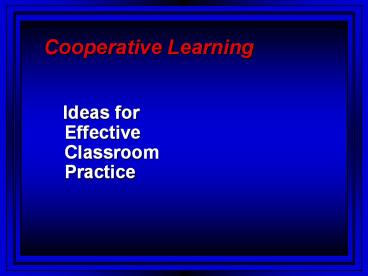Cooperative Learning - PowerPoint PPT Presentation
Title:
Cooperative Learning
Description:
Cooperative Learning Ideas for Effective Classroom Practice Cooperative Learning in the Physics Classroom The presentation is based upon the Learning Together ... – PowerPoint PPT presentation
Number of Views:122
Avg rating:3.0/5.0
Title: Cooperative Learning
1
Cooperative Learning
- Ideas for Effective Classroom Practice
2
Cooperative Learningin the Physics Classroom
- The presentation is based upon the Learning
Together model developed by Johnson, D.,
Johnson, R. Holubec, E. (1988). Circles of
Learning Cooperation in the Classroom. Edina,
MN Interaction Book Company. - Several other models exist (e.g., Slavin), but
the above model is perhaps the most applicable to
physics teaching.
3
Cooperative Learning v. Other Forms of Learning
- Cooperative learning is just one form of
classroom/student learning structure. - Other forms include
- Individualized (criterion-based grading system)
- Competitive (norm-based grading system)
- Cooperative learning is perhaps the most
important of the three types of learning
situations, yet it is the least used (lt20 time).
4
Cooperative LearningDefinitions Traits
- Cooperation -- working together to accomplish
shared goals - Cooperative Learning -- the instructional use of
small groups wherein students work together to
maximize their own and each others learning - Common Elements
- shared learning goals -- desired outcome in which
the students demonstrate as a group and
individually a mastery of the subject studied - goal structure -- specifies the ways in which
students will interact with each other and the
teacher during the instructional session
5
Not all group learning is cooperative learning.
- groups arguing over divisive conflicts and power
struggles - a member sits quietly, too shy to participate
- one member does the work, while the other members
talk about sports - no one does the work because the one who normally
works the hardest doesnt want to be a sucker - a more talented member may come up with all the
answers, dictate to the group, or work
separately, ignoring other group members
6
Effective Cooperation
- does not occur by chance.
- can not be based on the assumption that all
students possess good social and learning skills.
- occurs when the essential components required
for each cooperative activity are ensured.
7
Learning TogetherEssential Components
- PIGS FACE
- Johnson Johnson
8
Positive Interdependence
- Students have two responsibilities
- learn the assigned material
- ensure that all members of the group learn the
material - Each student should see his or her contribution
as essential for group success. - each student makes unique contribution
- Interdependence occurs when students cannot
succeed unless all their group members also
succeed. - Structuring interdependence common goal, joint
rewards, divided resources, complimentary roles
9
Individual Accountability
- Teacher must assess (directly or indirectly) how
much effort each member is contributing to the
groups work. - Teacher must provide feedback to groups and
individual students. - Teacher must help groups avoid redundant efforts
by members. - Teacher must ensure that every member is
responsible for the final outcome.
10
Group Processing
- At the end of the process, students reflect to
determine which member actions were helpful and
which were harmful. - Students then make decisions about which actions
to continue, change, or delete. - Such processing allows groups to
- focus on maintaining good working relationships.
- learn and improve cooperative skills.
- provide feedback on member participation.
- think at a metacognitive level as well as
cognitive level. - celebrate success of the group.
11
Social Skills
- Students must get to know and trust one another.
- Students must communicate accurately and
unambiguously. - Students must accept and support each other.
- Students must resolve conflicts constructively.
12
Face-to-Face Interaction
- Successful interaction occurs as a result of
positive interdependence. - To maximize opportunity for success
- keep groups small (2 - 6 students)
- keep groups heterogeneous within, homogeneous
without - assist students with guidelines for interaction
- acceptance, support, trust, respect
- exchange of information
- motivation
13
Whats the difference?
- Cooperative Group Traditional Group
- Positive interdependence No interdependence
- Individual accountability No individual
accountability - Heterogeneous membership Homogeneous
membership - Shared leadership One leader
- Responsible to each other Responsibly only
for self - Task maintenance emphasized Only task
emphasized - Social skills directly taught Skills assumed
or ignored - Teacher observes intervenes Teacher ignores
groups - Group processing occurs No group processing
- Mutual assistance Competitive
14
The Advisability of Using Cooperative Learning
- Works well with inquiry and constructivist
approaches. - Supports multiculturalism efforts.
- Promotes social development.
- Assists with classroom discipline.
- Provides for more than one teacher.
15
Cooperative Learning
- Cooperative learning has the best and largest
empirical base of any educational innovation. - Cooperative processes have been shown to advance
higher-level conceptual learning. - Cooperative learning at the high school level is
well worth exploring.
16
Instructional Examples
- Send-a-Problem
- TAPPS
- Think-Pair-Share
- Jigsaw Method
- Group Investigations (PBL)
- Structured Problem Solving































